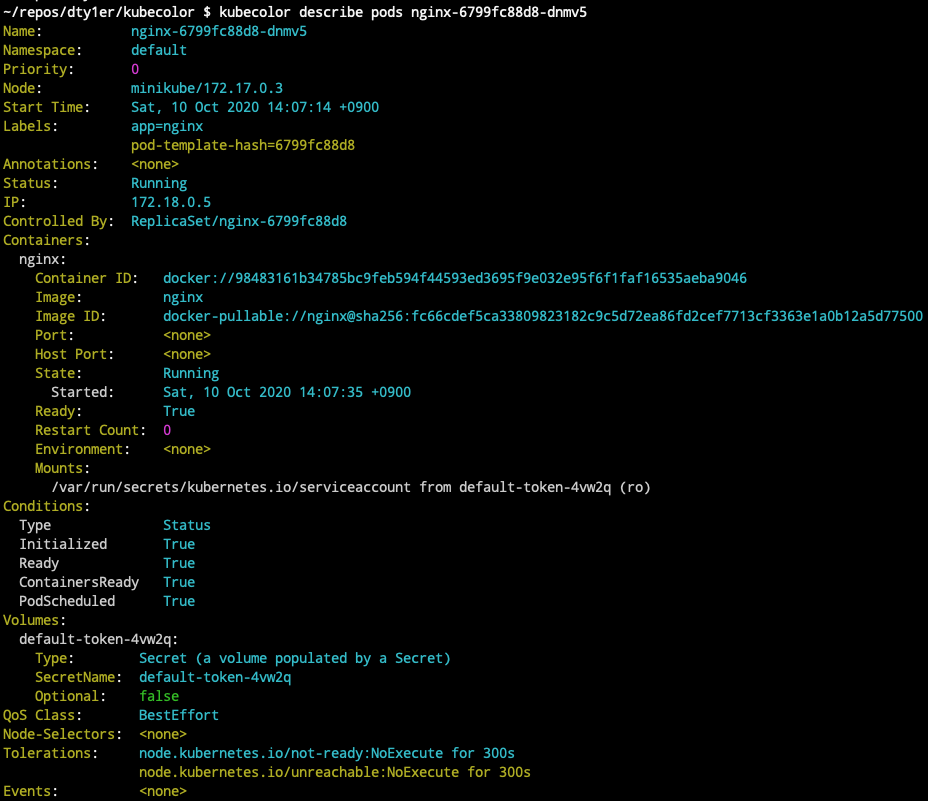kubecolor
Colorize your kubectl output
- get pods
- describe pods
- something wrong
- You can change color theme for light-backgrounded environment
What's this?
kubecolor colorizes your kubectl command output and does nothing else.
kubecolor internally calls kubectl command and try to colorizes the output so
you can use kubecolor as a complete alternative of kubectl. It means you can write this in your .bash_profile:
alias kubectl="kubecolor"kubecolor is developed to colorize the output of only READ commands (get, describe...). So if the given subcommand was for WRITE operations (apply, edit...), it doesn't give great decorations on it.
For now, not all subcommands are supported and will be done in the future. What is supported can be found below.
Even if what you want to do is not supported by kubecolor now, kubecolor still can just show kubectl output without any decorations,
so you don't need to switch kubecolor and kubectl but you always can use kubecolor.
Additionally, if kubectl resulted an error, kubecolor just shows the error message in red or yellow.
Installation
go get -u github.com/dty1er/kubecolor/cmd/kubecolorUsage
kubecolor understands every subcommands and options which are available for kubectl. What you have to do is just using kubecolor
instead of kubectl like:
kubecolor --context=your_context get pods -o jsonIf you want to make the colorized kubectl default on your shell, just add this line into your shell configuration file:
alias kubectl="kubecolor"Flags
--plain
When you don't want to colorize output, you can specify --plain. Kubecolor underntands this option and
outputs the result without colorizing. Of course, given --plain will never be passed to kubectl.
This option will help you when you want to save the output onto a file and edit them by editors.
--light-background
When your terminal's background color is something light (e.g white), default color preset might look too bright and not readable.
If so, specify --light-background as a command line argument. kubecolor will use a color preset for light-backgrounded environment.
Autocompletion
kubectl provides autocompletion feature. If you are already using it, you might have to configure it for kubecolor.
Basically, configuring autocompletion for kubecolor requires adding following line in your shell config file.
# autocomplete for kubecolor
complete -o default -F __start_kubectl kubecolorIf you are using an alias like k="kubecolor", then just change above like:
complete -o default -F __start_kubectl kPlease also refer to kubectl official doc.
Supported commands
Checked: Supported and works in current latest version
Unchecked: Will be supported but it's still under development
Not in the list: Won't be supported because it's not READ operation
kubectl commands
- kubectl get
- kubectl top
- kubectl describe
- kubectl explain
- kubectl logs
- kubectl api-rsources
- kubectl api-versions
- kubectl version
format options
- json
- wide
- yaml
- custom-columns
Other features which currently unsupported but will be done in the future
- make it works with -w option
- Configuring custom colors
- specifying multiple resources at once (e.g.
kubectl get pod,replicaset)- This will actually work, but if you don't specify "--no-headers" it might look a bit strange.
Known issues which will be fixed in the (near) future
- It does not work with kubectl exec -t option
Contributions
Always welcome. Just opening an issue should be also greatful.
LICENSE
MIT



